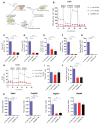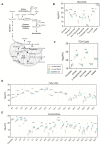Metabolic Changes during In Vivo Maturation of PSC-Derived Skeletal Myogenic Progenitors
- PMID: 38201280
- PMCID: PMC10778145
- DOI: 10.3390/cells13010076
Metabolic Changes during In Vivo Maturation of PSC-Derived Skeletal Myogenic Progenitors
Abstract
In vitro-generated pluripotent stem cell (PSC)-derived Pax3-induced (iPax3) myogenic progenitors display an embryonic transcriptional signature, but upon engraftment, the profile of re-isolated iPax3 donor-derived satellite cells changes toward similarity with postnatal satellite cells, suggesting that engrafted PSC-derived myogenic cells remodel their transcriptional signature upon interaction within the adult muscle environment. Here, we show that engrafted myogenic progenitors also remodel their metabolic state. Assessment of oxygen consumption revealed that exposure to the adult muscle environment promotes overt changes in mitochondrial bioenergetics, as shown by the substantial suppression of energy requirements in re-isolated iPax3 donor-derived satellite cells compared to their in vitro-generated progenitors. Mass spectrometry-based metabolomic profiling further confirmed the relationship of engrafted iPax3 donor-derived cells to adult satellite cells. The fact that in vitro-generated myogenic progenitors remodel their bioenergetic signature upon in vivo exposure to the adult muscle environment may have important implications for therapeutic applications.
Keywords: in vitro; in vivo; metabolism; myogenic progenitors; pluripotent stem cells; satellite cells.
Conflict of interest statement
R.C.R.P. is cofounder and holds equity in Myogenica. T.N. is a cofounder and holds equity in Omix Technologies. All other authors have no competing financial interests.
Figures




Similar articles
-
Pluripotent stem cell-derived myogenic progenitors remodel their molecular signature upon in vivo engraftment.Proc Natl Acad Sci U S A. 2019 Mar 5;116(10):4346-4351. doi: 10.1073/pnas.1808303116. Epub 2019 Feb 13. Proc Natl Acad Sci U S A. 2019. PMID: 30760602 Free PMC article.
-
Skeletal Muscle Stem Cells from PSC-Derived Teratomas Have Functional Regenerative Capacity.Cell Stem Cell. 2018 Jul 5;23(1):74-85.e6. doi: 10.1016/j.stem.2018.06.010. Cell Stem Cell. 2018. PMID: 29979993 Free PMC article.
-
Efficient Muscle Regeneration by Human PSC-Derived CD82+ ERBB3+ NGFR+ Skeletal Myogenic Progenitors.Cells. 2023 Jan 18;12(3):362. doi: 10.3390/cells12030362. Cells. 2023. PMID: 36766703 Free PMC article.
-
Generation of human myogenic progenitors from pluripotent stem cells for in vivo regeneration.Cell Mol Life Sci. 2022 Jul 8;79(8):406. doi: 10.1007/s00018-022-04434-8. Cell Mol Life Sci. 2022. PMID: 35802202 Free PMC article. Review.
-
Myogenic stem cells.Folia Histochem Cytobiol. 2008;46(4):401-12. doi: 10.2478/v10042-008-0060-1. Folia Histochem Cytobiol. 2008. PMID: 19141389 Review.
Cited by
-
Alcohol Impairs Bioenergetics and Differentiation Capacity of Myoblasts from Simian Immunodeficiency Virus-Infected Female Macaques.Int J Mol Sci. 2024 Feb 19;25(4):2448. doi: 10.3390/ijms25042448. Int J Mol Sci. 2024. PMID: 38397125 Free PMC article.
-
Effect of Notch1 signaling on muscle engraftment and maturation from pluripotent stem cells.Stem Cell Reports. 2025 Feb 11;20(2):102396. doi: 10.1016/j.stemcr.2024.102396. Epub 2025 Jan 30. Stem Cell Reports. 2025. PMID: 39889709 Free PMC article.
-
PAX translocations remodel mitochondrial metabolism through altered leucine usage in rhabdomyosarcoma.Cell. 2025 May 15;188(10):2757-2777.e22. doi: 10.1016/j.cell.2025.03.008. Epub 2025 Apr 3. Cell. 2025. PMID: 40185100
-
Metabolic regulation in adult and aging skeletal muscle stem cells.Genes Dev. 2025 Feb 3;39(3-4):186-208. doi: 10.1101/gad.352277.124. Genes Dev. 2025. PMID: 39662967 Free PMC article. Review.
References
-
- Ikemoto M., Fukada S., Uezumi A., Masuda S., Miyoshi H., Yamamoto H., Wada M.R., Masubuchi N., Miyagoe-Suzuki Y., Takeda S. Autologous transplantation of SM/C-2.6(+) satellite cells transduced with micro-dystrophin CS1 cDNA by lentiviral vector into mdx mice. Mol. Ther. 2007;15:2178–2185. doi: 10.1038/sj.mt.6300295. - DOI - PubMed
Publication types
MeSH terms
Grants and funding
LinkOut - more resources
Full Text Sources

